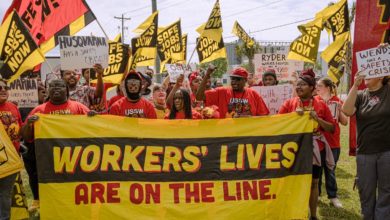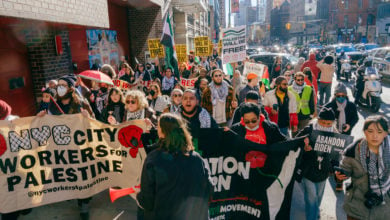On May 1, an estimated 600,000 supporters of the Unified
Communist Party of Nepal (Maoist) gathered in Kathmandu, Nepal’s capital for
International Workers Day. The demonstrators demanded the resignation of Prime
Minister Madhav Kumar Nepal and the creation of a “people’s constitution.” The
next day, the communists called for an “indefinite general strike” that shut
down the entire country for six days. On May 7, the leadership of the UCPN-M
announced the end of the general strike.
|
Nepal general strike, day 3 |
“We have decided to withdraw the indefinite strike,
considering the discomforts people were faced with,” said UCPN-M leader Pushpa
Kamal Dahal. “Our protest will now take a different nature and we reserve the
right to resume the indefinite strike at a later date.” To maintain
pressure on the government, UCPN-M indicated they would continue to block roads
to the Singha Durbar complex, which houses the
government.
The strike had come
under increasing attack. An estimated 20,000 professionals in Kathmandu marched
on May 7, calling for an end to the strike. According to journalist Jed Brandt,
“Vigilante gangs broke off from civil society peace march, attacking protesters
(with) rocks and sticks. Police respond by tear-gassing canteen, beating
Maoists who responded to the attack. Hindu-chauvinist groups attack Maoists
with police assistance in the Terai, targetting leaders.”
Issues behind the
general strike
The current government is led by the Communist Party of
Nepal (Unified Marxist-Leninist) with the backing of the Nepali Congress Party
and several other smaller groups. Despite its revolutionary sounding name, CPN
(UML) is a social democratic party and the NC is a reactionary, capitalist
party.
The UML-led government replaced one controlled by UCPN(M)
when the Maoists resigned in protest after the largely ceremonial president
unconstitutionally reinstated army chief Rookmangud Katawal.
Katawal had been sacked by Maoist Prime Minister Prachanda
for refusing to integrate the People’s Liberation Army—the military wing of the
UCPN(M)—into the Nepal Army. Reactionary and capitalist-oriented forces have
fought this fiercely.
The very same bourgeois parties that joined forces with the
Maoists to overthrow the monarchy now want to put the brakes on the
revolutionary process. They are content with establishing a capitalist
democracy. For the Maoists, however, the present situation is only a step on
the road to socialism. The integration of the PLA cadres—and particularly its
officer corps—would directly impact the Nepal Army’s class composition and
affect the balance of forces in favor of the workers.
The next few weeks are of critical importance to the class
struggle in Nepal. On May 28, the Constituent Assembly, a body tasked with
writing a new constitution after the hated monarchy was overthrown in 2006,
will lose its mandate. Very little progress has been made in drafting the
constitution.
Political polarization took place quickly over the past few
months, and UCPN(M) began what it called “decisive agitation” on International
Workers’ Day. Responding to government threats to repress the demonstrations,
massive self-defense trainings were administered to thousands of communist
cadre and supporters.
The feudal and capitalist establishment became hysterical.
Both the reactionary Nepal Army and the Maoists’ armed wing, the People’s
Liberation Army, were put on high alert.
Despite the tension, the May 1 demonstration was both
massive and peaceful, thanks largely to the efforts of the highly disciplined,
Maoist-affiliated Young Communist League.
The general strike brought the country to a total
standstill. Photographs from the first few days of the strike show strikers in
a festive mood, with singing and dancing characterizing many of the
demonstrations.
On May 4, 70,000 strikers lined the entire Ring Road, which
stretches more than 17 miles and encircles Kathmandu. The next day, the
communists announced an intensification of their protests and encircled Singha
Durbar, the compound that houses the main government institutions.
The fourth day of the strike also saw more clashes between
strikers and reactionaries, including one incident where gunshots were fired
toward the crowd.
High-stakes talks between the Maoists, CPN(UML) and NC
continued throughout the general
strike. While the leaders have discussed a range of issues, the main dispute is
over the resignation of M.K. Nepal, who is widely seen as a puppet of the
Indian government and is under pressure from senior leaders of his own party to
step down.
UCPN(M) is demanding that M.K. Nepal resign as a
precondition for a consensus agreement.
The government refuses to do so until a “package solution” is settled
upon.
While communist-led forces are publicly calling for a
national government under their leadership rather than a full-blown revolution,
they are keeping their options open. Maoist Vice-Chairman Baburam Bhattarai
defiantly stated on the second day of the strike, “If the rulers continue to
ignore our demands … the upcoming historical war will cost the government
dear[ly].” (Kantipuronline.com, May 3)
The U.S. government is doing everything it can to maintain
the status quo in Nepal. In addition to interference from the U.S. ambassador
and State Department officials, Adm. Robert Willard of the U.S. Navy recently
visited the country. The purpose of Willard’s visit was especially transparent
considering that Nepal is a landlocked country.
At a time when the world capitalist economy is undergoing a
profound contraction, the workers and peasants of Nepal are fighting back with
a massive revolutionary struggle. Although the general strike has ended, the
struggle is taking new forms.
During this crucial juncture, the Nepalese people need our solidarity
more than ever.






